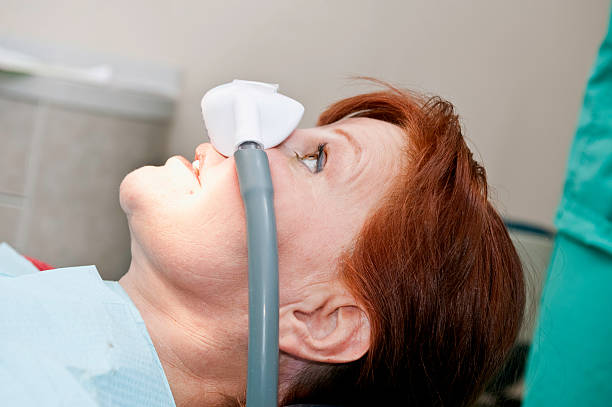Going to the dentist can be a source of anxiety for many. But what if there was a way to alleviate that fear and make your dental visit a more comfortable experience? That's where sedation dentistry comes in.
This Eddie G Tennison DDS article will delve into the various types of sedation dentistry, helping you understand which option might be right for you.
We'll explore everything from minimal sedation to general anesthesia, and how they can transform your dental experience.
What is Sedation Dentistry?
Sedation dentistry uses medication to help patients relax during dental procedures. It ranges from minimal sedation, where you're awake but relaxed, to general anesthesia, where you're completely unconscious.
Think of it like a dimmer switch for your anxiety – we can adjust the level of sedation to meet your individual needs.
Benefits of Sedation Dentistry
Sedation dentistry at Eddie G Tennison DDS offers a multitude of benefits:
- Reduces anxiety and fear
- Allows for more complex procedures to be completed in one visit
- Minimizes discomfort and pain
- Helps patients with dental phobia receive necessary care
- Enhances patient cooperation, especially in children or those with special needs
Who is a Good Candidate for Sedation Dentistry?
Sedation dentistry isn't just for the faint of heart. It can be beneficial for:
- Individuals with dental anxiety or phobia
- Patients undergoing lengthy or complex procedures
- People with a strong gag reflex
- Those with sensitive teeth
- Patients with physical limitations that make it difficult to sit still
Common Myths About Sedation Dentistry
Let's dispel some common misconceptions:
- Myth: Sedation dentistry is only for extreme cases of anxiety. Fact: It can be used for any level of anxiety, even mild.
- Myth: Sedation dentistry is dangerous. Fact: When administered by a trained professional, it's generally safe.
- Myth: Sedation dentistry means you'll be completely unconscious. Fact: There are different levels of sedation, and you may remain awake for some treatments.
Understanding Different Types of Sedation in Dentistry
The Sedation Techniques
Sedation dentistry encompasses a range of techniques, each with its own level of sedation. These include oral sedation, inhalation sedation, IV sedation, deep sedation, and general anesthesia. We'll examine each of these in detail.
Factors to Consider in Choosing the Right Sedation
Choosing the right type of sedation depends on several factors:
- Your level of anxiety
- The type and length of the procedure
- Your medical history
- Your personal preferences
Minimal Sedation
What is Minimal Sedation?
With minimal sedation, you're awake but relaxed. You can respond to verbal commands, and you're generally aware of your surroundings. It's like taking the edge off your anxiety.
When to Use Minimal Sedation in Dental Procedures
Minimal sedation is often used for routine treatments like cleanings, fillings, or simple extractions.
Pros and Cons of Minimal Sedation
Pros: Easy to administer, minimal side effects, quick recovery.
Cons: May not be sufficient for high levels of anxiety or complex procedures.
Moderate Sedation
What is Moderate Sedation?
Moderate sedation, sometimes referred to as conscious sedation, allows you to feel more drowsy. You may slur your words, but you can still respond to verbal cues.
How Moderate Sedation is Administered
Moderate sedation can be administered orally or intravenously.
Ideal Situations for Moderate Sedation in Dentistry
This level of sedation is often used for more involved procedures like root canals or wisdom tooth extractions.
Potential Side Effects and Risks of Moderate Sedation
Side effects can include drowsiness, dizziness, and nausea. Risks are generally minimal but should be discussed with your dentist.
Deep Sedation
What is Deep Sedation?
With deep sedation, you're on the edge of consciousness. You can be awakened with gentle stimulation, but you may not be able to respond to verbal commands.
Procedures That May Require Deep Sedation
Deep sedation might be used for extensive dental work or for patients with severe anxiety.
Deep Sedation vs. General Anesthesia
Deep sedation is similar to general anesthesia, but it doesn't require airway support.
General Anesthesia in Dentistry
Overview of General Anesthesia
General anesthesia renders you completely unconscious. You're asleep throughout the procedure and unaware of anything.
When General Anesthesia is Necessary in Dentistry
General anesthesia is typically reserved for complex oral surgery, patients with certain medical conditions, or those with extreme dental phobia.
Safety Considerations for General Anesthesia in Dental Treatments
General anesthesia is generally safe when administered by a qualified anesthesiologist. However, it carries slightly higher risks than other forms of sedation.
Oral Sedation
How Oral Sedation Works
Oral sedation involves taking medication, usually in pill form, before your dental appointment.
Types of Medications Used for Oral Sedation
Common medications include benzodiazepines like Valium or Ativan.
Advantages and Disadvantages of Oral Sedation
Advantages: Easy to administer, non-invasive.
Disadvantages: Effects can be unpredictable, may not be suitable for all levels of anxiety.
Inhalation Sedation
What is Inhalation Sedation?
Inhalation sedation involves breathing in a combination of nitrous oxide (laughing gas) and oxygen.
Nitrous Oxide and Its Role in Sedation Dentistry
Nitrous oxide helps you relax and reduces anxiety.
Benefits and Drawbacks of Inhalation Sedation
Benefits: Quick onset and recovery, easily adjustable.
Drawbacks: May not be strong enough for some patients, effects wear off quickly.
IV Sedation (Intravenous Sedation)
How IV Sedation is Administered
IV sedation is administered through a vein, allowing for precise control of the medication.
Pros and Cons of IV Sedation in Dentistry
Pros: Highly effective, allows for deeper levels of sedation, quicker recovery than oral sedation.
Cons: Requires a trained professional to administer, slightly higher risk of complications.
Ideal Candidates for IV Sedation
IV sedation is often used for patients with moderate to high levels of anxiety, those undergoing complex procedures, or those who don't respond well to other forms of sedation.
Comparing Types of Sedation Dentistry
Effectiveness of Each Type of Sedation
The effectiveness of each type of sedation varies depending on the individual and the procedure.
Cost Comparison of Sedation Options
Sedation costs vary depending on the type of sedation, the length of the procedure, and your location.
Duration and Recovery Time for Different Sedation Types
Recovery time varies depending on the type of sedation. Minimal sedation often requires little to no recovery time, while general anesthesia may require a longer recovery period.
Preparing for a Sedation Dentistry Procedure
Pre-Sedation Instructions for Patients
Your dentist will provide you with specific instructions before your sedation appointment. These may include fasting, avoiding certain medications, or arranging for transportation.
Tips for a Comfortable Experience
Communicate your concerns with your dentist, wear comfortable clothing, and try to relax before your appointment.
Sedation Dentistry for Special Populations
Sedation Options for Children
Sedation dentistry can be safely used in children to help them relax during dental procedures.
Sedation Dentistry for Patients with Disabilities
Sedation can be particularly helpful for patients with physical or cognitive disabilities who may have difficulty cooperating with dental treatment.
Anxiety and Fear Management in Dental Sedation
Sedation dentistry plays a crucial role in managing dental anxiety and fear, allowing patients to receive the necessary care they need.
Choose Eddie G Tennison DDS for Your Sedation Dentistry Needs
Looking for expert sedation dentistry in Round Rock, Texas? Eddie G Tennison DDS has been providing quality dentistry since 1988. Dr. Tennison is a board-certified pediatric dentist and a highly skilled general dentist.
His comprehensive approach means you get the care you need—from sedation to orthodontics—all services in one place.
Book with Eddie G Tennison DDS today for a stress-free dental experience!
Conclusion

Sedation dentistry has revolutionized how we approach dental care, making it possible for even the most anxious patients to receive the treatment they need.
By understanding the different types of sedation available, you can work with your dentist at Eddie G Tennison DDS to choose the option that best suits your individual needs and ensures a comfortable and positive dental experience.
Don’t let fear keep you from a healthy smile!

